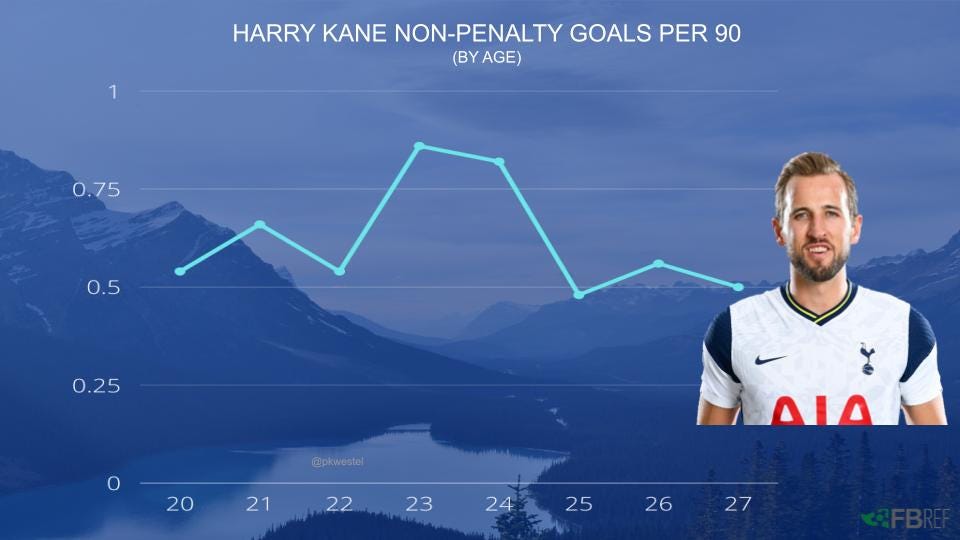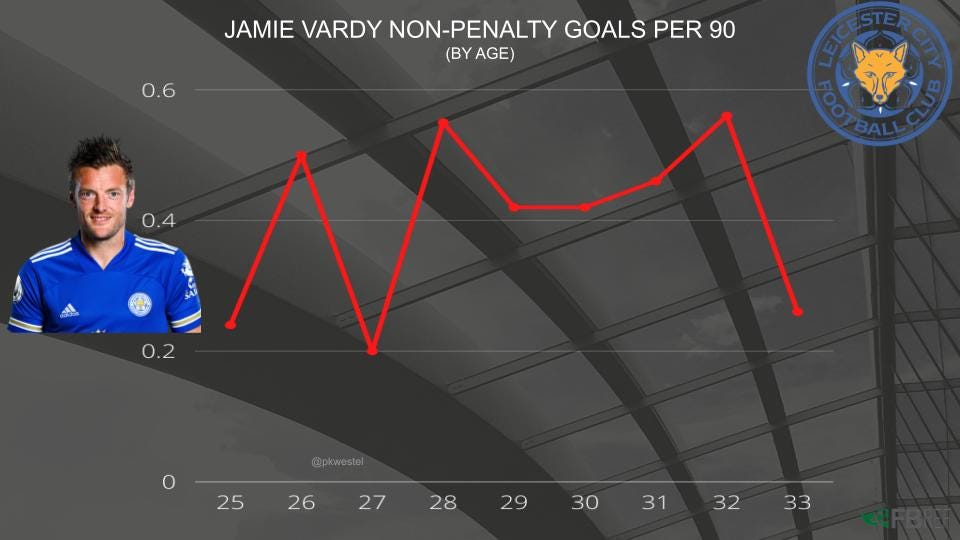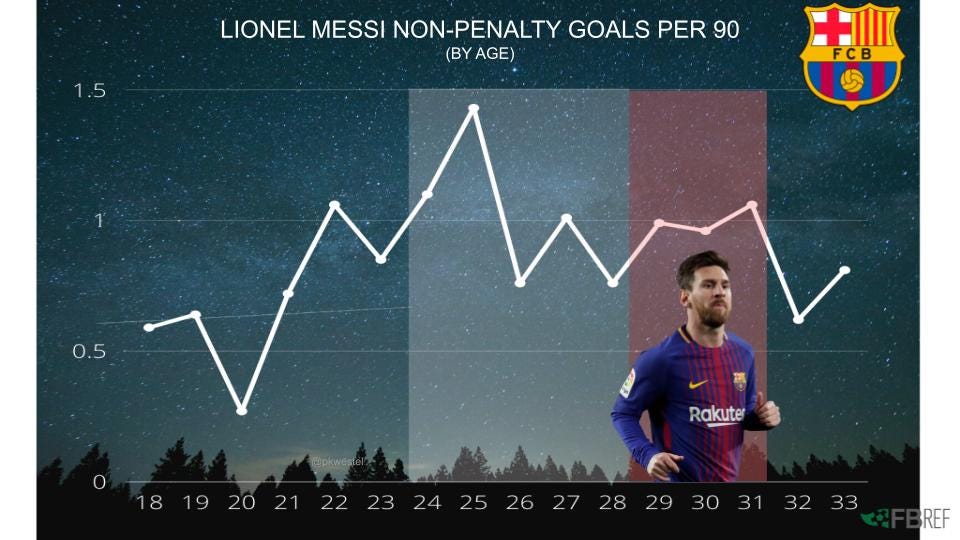£100 million for Harry Kane? Why you shouldn't touch that with a 10 foot pole.
Age curves are a very real thing that clubs around the world are catching up on.
If the craziness of the past year has made you lose all awareness of things like “time” and “what’s todays date?” then this week served to remind you that we’re entering the end of March. That reminder came in the form of the Harry Kane may be looking to leave Tottenham this summer rumors that flooded the football world early this week.
It didn’t take me long to remember that this is an annual occurrence. Matt Law wrote an article in the Telegraph on how Kane might be considering his future if Spurs don’t qualify for the Champions League last March. He wrote the same article 367 days prior.
But this year seems like it maybe could be different. If only because for the first time since Harry Kane broke through, the situation at Tottenham doesn’t look like there’s hope on the horizon. In the Pochettino years they were always building something and getting better. Last year Jose Mourinho was there to take them to the next level.
That has very much not happened and Hugo Lloris’ interview last week shined light that things inside the Tottenham dressing room are far from good. It doesn’t take a genius to look at this Spurs team and see that they need to be shaken up. That’s not going to be a quick or easy process and it’s totally fair to wonder if Kane wants to stick around for all that.
In theory selling Kane would give Spurs some nice funding to kick start their rebuild. But that’s “in theory.” Spurs still view Kane as a player who could command a £100 million transfer fee and are unlikely to sell him for anything less.
The reality is quite different. Even in a non-COVID world, it’s hard to see how any team in 2020-21 would be willing to fork over £100 million for Harry Kane. The clubs that can afford that have all - for the most part - become smart enough not to make those kinds of deals.
Why not?
Because age curves are a thing, and clubs have started to realize that.
In 2013 Michael Caley first wrote about aging in football and it’s effect on performance. When do players hit their peak? How long does their prime last for? In 2017 he went into even more depth on the subject.
Caley’s research found that players peak a lot sooner than conventional wisdom holds and their skills diminish even faster. According to Caley most players hit their peak between the ages of 25 to 28 depending on their position. Wide attackers peak the earliest while centerbacks often don’t hit their peak until between the ages of 30 to 32.
This suggests a general rule. Players tend to get slower and generally lose athleticism as they age, but they also gain skills and know-how to balance that out. Positions that require the most athleticism are a young person's game, whereas older players will more often be found at positions that most prize guile.
This all has to do with minutes played. Every minute played wears on your body. As Ryan O’Hanlon put it this week, when you’re young you need to train your body to be able to do things it’s never done before week after week. As you get older your body starts pushing back and no longer moves as quickly or as easily. Every minute you’re playing at the top level brings you closer to that point.
Wide attackers and forwards tend to break into the first team earliest. Their positions have the least defensive responsibilities so managers aren’t as afraid to give them chances. Midfielders and centerbacks, where physicality and IQ are bigger requirements break in later. Getting called up to your national team adds even more minutes to wear down your legs.
Players can fight this off by changing positions on the pitch. Wayne Rooney spent a lot more time in midfield as he got older. Paul Scholes dropped deeper in midfield and made fewer runs into the box. Ryan Giggs moved from the wing to central midfield where there was far less running. Cristiano Ronaldo moved from a hybrid winger to a true striker.
Your league matters as well. The Premier League is very physical and top to bottom provides the most quality of teams. There are no easy games in England. The Bundesliga has quality and pace, but is less physical. La Liga offers physicality but plenty of minnows who you can get past without giving 100 percent. In Italy the pace (slow) and physicality (little) of Serie A lends itself great to older players.
According to Caley’s research attacking players hit their prime around 24 and peak at the age of 26. Their production then begins dropping slowly until the age of 30, where it really jumps off a cliff.
When circling back to Kane it’s important to understand the difference between “prime” and “peak.” Your prime is the period of your best years. Your peak is your best year full stop. In theory, a player like Marcus Rashford could already be ‘past his peak’ if he never replicates the 0.39 NpG/90 and 0.62 NpG+A/90 he put up in 2019. We won’t actually know until his career is over.
In the olden days, when clubs were looking to sign players they did what any company would do when they’re looking to hire someone new. You look at their C/V. In football that’s your goals record.
Kane’s record is very impressive. Four straight seasons of over 20 goals shows he’s been able to get it done at this level. But what football teams have realized, is that what you did at 22 or 23 doesn’t exactly tell you what a player is going to do at 29 or 30.
Thanks to looking at age curves and data we can get a much better idea if you’re going to hit those numbers again. In Rashford’s case, he most likely will. In Kane’s case, not so much.
This summer Kane will be 28 years old. That’s the tail end of his prime and most likely past his peak, which actually came pretty early.
Kane’s 25 and 26 year old seasons were derailed by injuries but even this year when he’s seemingly picked things up (he’s added assists to his game thanks to Heung Min Son, his goals per 90 has still dropped this season.
The other thing is, he’s got injuries on his C/V, and while goals and assists may not be indicative of future performance, players that have injury histories tend to keep those injury histories.
These trends are pretty consistent among all top strikers.
Robin van Persie had his most productive year at the age of 26. He then slowly declined for a few years (still staying very productive) before dropping sharply at age 30.
Wayne Rooney is a similar story. The heart of his three year prime was derailed by an injury but got back to that level the following year before starting a slow decline and turned into a big decline.
Rooney hit his prime a few years earlier but that’s because he broke into first team football at the age of 16 (as opposed to 18-19 as most stars do). By 17 he was already playing international football. In Louis van Gaal’s second season Rooney looked washed up already. He was only 28!
At the top levels players typically have about 10-11 years from when they fully break in until they really deteriorate. They typically hit their peaks around 5-6 years in.
There are obviously outliers. First in terms of age there’s Jamie Vardy.
Vardy didn’t break in to top flight football until he was 25. That’s not to say that all the minutes he logged in non-league and lower level football don’t count but even with those teams playing twice a week you’re not pushing your body to the level it’s required to be at to play in the Premier League. That’s helped Vardy maintain his prime a bit later than most attacking players (including a freak second peak) but hasn’t been able to maintain it.
The other outliers are of course, the freaks.
There’s Messi…
Messi who frankly has a very similar pattern to most. He rose through his 20’s, peaked at the age of 25 and leveled out for the next few years. The key difference is he managed to extend that leveling by a few years until he was 31 and oh yea, when he leveled out he was still hovering around 1.0 NPG per 90!
And then of course there’s Ronaldo.
Ronaldo seemed to have made his leap one year too early (but also no one was scoring in the Premier League in 2008-09). He then continued to rise for the next few years and being the freak of nature that Ronaldo is didn’t peak until 29. He then fell off a bit with a one year spike (thanks to playing significantly fewer minutes keeping him fresh) before finding a resurgence in Serie A, which as we already covered lends itself pretty well to older players.
Ronaldo and Messi are - and have always been - freaks of nature. Add in Robert Lewandowski (who benefits from playing in Germany) and we can’t expect anyone to do what they do.
Kane’s comparisons should stick to the the Aubameyang’s (do we need to mention what he’s doing at the age of 31?), Van Persie’s, and Rooney’s of the world. Elite strikers who aren’t in the ‘outliers’ category.
None of this is to say that Kane is past it or won’t be good. All that data in fact suggests that Kane might very well hit another spike in the next two years.
The issue here is Kane hasn’t hit 20 non-penalty goals in three years. He hasn’t come close to the 0.86 NpG/90 he put up in 2017. That itself isn’t the highest peak compared to the top strikers in Europe. Sergio Aguero put up a 1.0 at age 25 then hovered around 0.75-0.8 for the next four years. When he works to fight off father time and randomly has a spike at age 31 he puts up a 0.87.
The question is, is that worth a £100 million transfer fee (plus agents fees etc)?
I would say the answer is no, and it’s starting to look like the top teams in Europe agree. Take a look at the 10 largest transfer fees that last summer’s window.
Only three players are above the age of 25. One of whom (Pjanic) was involved in a swap deal - and moved to Italy. Another (Icardi) technically moved last year in a loan to buy agreement. He’s got five goals and three assists this season and his 0.49 NpG/90 is a far cry from the 0.85 he put up last year (at age 26!). Hard to say that’s been a successful deal.
All of this of course came in COVID times, where big clubs were sitting things out because they didn’t have any money. Let’s look at the most expensive transfers from 2019-20, the last ‘normal’ transfer window.
This time we have four players above the age of 25. One is a striker who again is going to Italy. Another is a centerback and we know they hit their peaks later.
Then there’s the famous Antoine Griezmann and Eden Hazard deals. Two £100 million deals for players that were the same age as Kane will be next year. How have they worked out? Griezmann hasn’t exactly been a success at the Nou Camp and Hazard? Lol.
Real Madrid stopped signing players over the age of 26-27 at the start of the decade but somehow broke that policy for Hazard. Everyone else seemed to get the memo. The next player above the age of 27 on the list is Wissam Ben-Yedder who moved from Sevilla to Monaco for £36 million (about €40m). The twenty-fourth most expensive transfer of the summer.
In 2018-19 only two players aged 28 or over were in the top 20 most expensive transfers. 33 year old Cristiano Ronaldo (shocker, moving to Italy) who again, is Ronaldo, and 30 year old Paulinho who went from Barcelona to China.
2017-18 featured three players 28 or older in the top 20 most expensive transfers. Diego Costa moved from Chelsea to Atletico Madrid in a £54 million deal, 29 year old Nemanja Matic joined Manchester United, and 30 year old Leonardo Bonucci moved from Juventus to AC Milan.
How did those deals work out? Costa has scored 12 league goals in four years, Matic is in his fourth year at United and is quickly becoming deadweight, and Bonucci lasted one season at the San Siro before he was sent back to Juventus.
Clubs have realized that the track record here ain’t that great.
None of this is to say that once you hit 30, you’re definitely going to stop scoring. A quick look at the top six players in non-penalty goals across Europe’s top five leagues yields a lot of familiar names.
Lewandowski (age 32)
Messi (33)
Erling Haaland (20)
Ronaldo (36)
Karim Benzema (33)
Luis Suarez (34)
Five of the top six are over 30. But other than Ronaldo none of those guys moved for big money late in their careers. Messi has always been with Barcelona. Lewandowski joined Bayern (on a free) at 25. Benzema moved to Real at 21. Suarez joined Atletico Madrid this season for the hefty fee of €6 million.
This is what Kane’s career is likely going to be over the next few years. He’ll have another spike or two before be hits 31. He may even hit 20 non-penalty goals again. But that’s a lot of may, there’s no certainty in that, and it’s all the more probable that if he hits 20 goals again it only happens once.
If I’m going to pay £100 million for Harry Kane, I want the Kane that’s hitting 20+ goals a season four years in a row, not the one who might do it once.
Unfortunately it’s the latter one who’s available, and unless the price changed to reflect that I’d take my money elsewhere. I’ve got a feeling the top clubs in Europe will do the same.
Yes there are reports that Manchester City are interested in him but I wouldn’t place too much stock in those. There have also been reports that City can’t afford Kylian Mbappe and still haven’t struck a new deal with Kevin de Bruyne because they can’t agree on wages. All this comes a season after City got into hot water with UEFA over alleged FFP violations and it sounds like they’re a club that’s going to start being a little less frivolous with their money (relatively of course). Not to mention the last time City signed a player aged 28 or older was 2016.
Harry Kane is really good. He’s going to still be good and productive for another few years. It’s just, unless he let’s his contract run out and leaves on free, he’s most likely going to continue being good for Tottenham.













Good article, but why don't you compare Kane to Shearer, Ibrahimovic, or Wright? Shearer scored 23 goals at 33 and 22 at 35. Ian Wright destroyed the League at Arsenal.
A very interesting and cogent article, as usual. Please keep them coming.
How do you think MU should approach this market (in terms of incomings and outgoings) and for what objectives next year?
Do you think Solksjaer deserves a new contract?